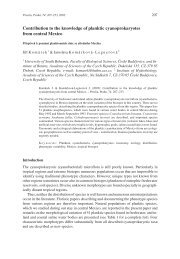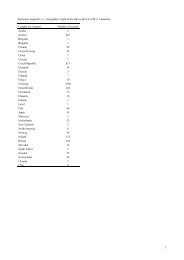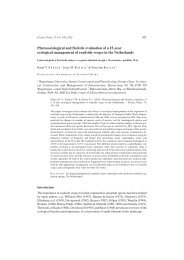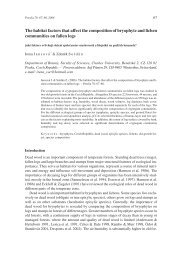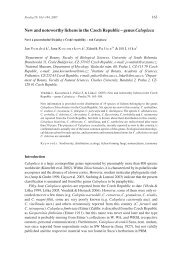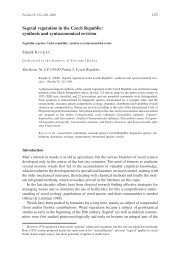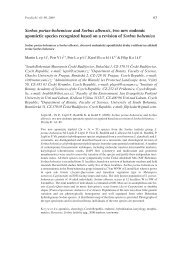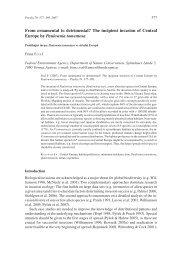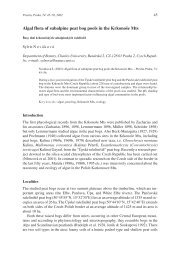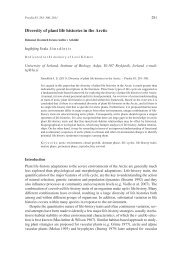Dandelions in Central Asia: Taraxacum sect. Suavia
Dandelions in Central Asia: Taraxacum sect. Suavia
Dandelions in Central Asia: Taraxacum sect. Suavia
Create successful ePaper yourself
Turn your PDF publications into a flip-book with our unique Google optimized e-Paper software.
Preslia, Praha, 77: 263–276, 2005 263<br />
<strong>Dandelions</strong> <strong>in</strong> <strong>Central</strong> <strong>Asia</strong>: <strong>Taraxacum</strong> <strong>sect</strong>. <strong>Suavia</strong><br />
Rod <strong>Taraxacum</strong> v Centrální Asii: sekce <strong>Suavia</strong><br />
Jan K i r s c h n e r 1 1, 2<br />
& JanŠtěpánek<br />
1 Institute of Botany, Academy of Sciences, CZ-25243 Průhonice 1, Czech Republic, e-mail:<br />
kirschner@ibot.cas.cz, stepanek@ibot.cas.cz; 2 Herbarium Charles University Prague,<br />
Benátská 2, CZ-12801 Praha 2, Czech Republic<br />
Kirschner J. & Štěpánek J. (2005): <strong>Dandelions</strong> <strong>in</strong> <strong>Central</strong> <strong>Asia</strong>: <strong>Taraxacum</strong> <strong>sect</strong>. <strong>Suavia</strong>. – Preslia,<br />
Praha, 77: 263–276.<br />
On the basis of the authors' collections and cultivated material from <strong>Asia</strong>, a recently described group<br />
of dandelions, <strong>Taraxacum</strong> <strong>sect</strong>. <strong>Suavia</strong>, is revised. In addition to three species described previously<br />
(T. haneltii, T. sumneviczii and T. formosissimum), six new species from Mongolia and Kyrgyzstan<br />
are recognized. Three of them, T. suave, T. stupendum and T. margaritarium, possess most of the<br />
features characteriz<strong>in</strong>g the <strong>sect</strong>ion <strong>Suavia</strong>, one, T. suasorium, is regarded as <strong>in</strong>termediate between<br />
<strong>sect</strong>ions <strong>Suavia</strong> and Leucantha, whilst the rema<strong>in</strong><strong>in</strong>g two, T. nobile and T. venustius, exhibit some<br />
characters of another related <strong>sect</strong>ion (T. <strong>sect</strong>. Stenoloba). The members of the <strong>sect</strong>ion <strong>Suavia</strong> are<br />
agamospermous. Detailed descriptions, draw<strong>in</strong>gs and an identification key are given.<br />
K e y w o r d s : agamospermy, the Altai, Kyrgyzstan, Mongolia, <strong>Taraxacum</strong>, taxonomy<br />
Introduction<br />
The <strong>sect</strong>ional taxonomy of steppe and subsal<strong>in</strong>e dandelions <strong>in</strong> <strong>Central</strong> <strong>Asia</strong> was recently<br />
summarized (Kirschner & Štěpánek 2004). Several new <strong>sect</strong>ions were described <strong>in</strong>clud<strong>in</strong>g<br />
the <strong>sect</strong>ion <strong>Suavia</strong>. Two species, now classified as members of the <strong>sect</strong>ion <strong>Suavia</strong>,<br />
T. sumneviczii Schischk. and T. haneltii Soest, were known before this publication <strong>in</strong><br />
which the type species, T. formosissimum Kirschner & Štěpánek, and the <strong>sect</strong>ion were described.<br />
Dur<strong>in</strong>g the analysis of our material it turned out that several new species, clearly<br />
belong<strong>in</strong>g to the <strong>sect</strong>ion <strong>Suavia</strong>, occur <strong>in</strong> Tien Shan. In the present paper, we give a detailed<br />
taxonomic account of the <strong>sect</strong>ion <strong>Suavia</strong> and describe five new species.<br />
Material and methods<br />
About 60,000 specimens of <strong>Taraxacum</strong> are deposited <strong>in</strong> the herbarium PRA, Institute of<br />
Botany, Academy of Sciences, Průhonice, Czech Republic. Most of the material was collected<br />
by expeditions to many regions of the Mediterranean, Middle <strong>Asia</strong> (the former Soviet<br />
Middle <strong>Asia</strong>, i.e., Kazakhstan, Kyrgyzstan, Tadzhikistan, Turkmenistan and<br />
Uzbekistan) and <strong>Central</strong> <strong>Asia</strong> (ma<strong>in</strong>ly S Siberia, Mongolia and NW Ch<strong>in</strong>a) or reared from<br />
seed obta<strong>in</strong>ed from other botanists, or from roots or seed collected on expeditions. Details<br />
of the cultivation methods are given <strong>in</strong> Kirschner & Štěpánek (1993).<br />
Our expeditions to <strong>Central</strong> Siberia (1985) and the Altai (1988) were particularly important<br />
for the study of the <strong>sect</strong>ion <strong>Suavia</strong>. Valuable material used <strong>in</strong> the present study was<br />
collected (both fruit and herbarium specimens) by R. Bus<strong>in</strong>ský <strong>in</strong> Tien Shan (mostly the
264 Preslia 77: 263–276, 2005<br />
current Kyrgyzstan) and J. Soják (a series of sites along the foot of the Bogdo Ula (Bogduul)<br />
mounta<strong>in</strong>s <strong>in</strong> the vic<strong>in</strong>ity of Ulan Bator, Mongolia).<br />
Our study was supplemented by the exam<strong>in</strong>ation of numerous herbarium collections.<br />
Those most relevant to the present study are BM, E, GAT, K, LE, NS, S, UPS, W, WU. It<br />
should be added that our revision labels are numbered and refer to the specimen to which<br />
they are attached (not to the duplicates).<br />
The mode of reproduction (agamospermy versus sexuality) is easy to determ<strong>in</strong>e <strong>in</strong><br />
liv<strong>in</strong>g cultivated plants (by means of emasculation or observation of the variation among<br />
leaf rosettes of sibl<strong>in</strong>gs <strong>in</strong> cultivation). In herbarium material, pollen presence/absence and<br />
variation <strong>in</strong> pollen size are recorded (Nijs et al. 1990); marked variation <strong>in</strong> pollen size is,<br />
with certa<strong>in</strong> exceptions, a reliable <strong>in</strong>dicator of dandelion agamospermy.<br />
Plant nomenclature follows Kirschner & Štěpánek (1997) and the pr<strong>in</strong>ciples of <strong>sect</strong>ional<br />
taxonomy outl<strong>in</strong>ed <strong>in</strong> Kirschner & Štěpánek (1996). Achene length <strong>in</strong> the descriptions<br />
<strong>in</strong>cludes the cone.<br />
Results<br />
<strong>Taraxacum</strong> <strong>sect</strong>. <strong>Suavia</strong> Kirschner et Štěpánek, Folia Geobot. 39: 264 (2004)<br />
Type: <strong>Taraxacum</strong> formosissimum Kirschner et Štěpánek<br />
D e s c r i p t i o n : Ma<strong>in</strong> flower<strong>in</strong>g season: spr<strong>in</strong>g. Plants small or medium-sized, plant<br />
base with a tunica of brownish dry petioles. Leaves deeply lobate, lobation pattern often<br />
complicated, lobes most often patent, petioles narrow, unw<strong>in</strong>ged. Scapes densely aranose.<br />
Involucre with rounded to slightly truncate base, usually of medium width (ca 7–10 mm<br />
wide). Exterior and <strong>in</strong>terior <strong>in</strong>volucral bracts flat, less often slightly callose. Exterior<br />
bracts 9–12, <strong>in</strong> some species to 18, ± subapically imbricate, adpressed, round-ovate to<br />
broadly ovate, usually to 5–6 (7) mm long, pale to dark green, often suffused purplish near<br />
the apex, usually corniculate, with broad paler marg<strong>in</strong>s, sparsely ciliate or ciliate. Pollen<br />
present (variable <strong>in</strong> size) or absent, stigma yellow or discoloured. Achenes 4.5–5.0 mm<br />
long, usually 0.9–1.0 mm thick, gradually and <strong>in</strong>dist<strong>in</strong>ctly narrow<strong>in</strong>g <strong>in</strong>to the cone, achene<br />
body greyish stram<strong>in</strong>eous or reddish, or deep red, densely sp<strong>in</strong>ulose above, sp<strong>in</strong>ules short,<br />
th<strong>in</strong>, cone conical-subcyl<strong>in</strong>drical, 0.4–0.9 mm long. Rostrum slightly thickened, 3–6 mm<br />
long, pappus 5–6 mm long, white or whitish-yellowish.<br />
The <strong>sect</strong>ion comprises species of steppe and semisteppe habitats or gravelly to sandy<br />
places <strong>in</strong> N Mongolia, and adjacent territories of the Altai <strong>in</strong> the Russian Federation. Another<br />
diversity centre of the <strong>sect</strong>ion is <strong>in</strong> the Tian Shan, Kyrgyzstan; the occurrence of the<br />
<strong>sect</strong>ion <strong>in</strong> the Ch<strong>in</strong>ese part of the latter mounta<strong>in</strong> range <strong>in</strong> X<strong>in</strong>jiang is highly probable.<br />
The character comb<strong>in</strong>ation dist<strong>in</strong>guish<strong>in</strong>g the <strong>sect</strong>ion <strong>in</strong> <strong>Asia</strong> <strong>in</strong>cludes the deeply dis<strong>sect</strong>ed<br />
leaves with l<strong>in</strong>ear, patent lobes and often lobulate <strong>in</strong>terlobes, dist<strong>in</strong>ctly hairy<br />
scapes, broadly ovate outer bracts with relatively blunt apex (with ± straight marg<strong>in</strong>s near<br />
the apex, not acum<strong>in</strong>ate), ciliate and broadly bordered, large fruits with dense sp<strong>in</strong>ules,<br />
fruit body gradually narrow<strong>in</strong>g <strong>in</strong>to a relatively short cone and a short rostrum to the<br />
achene. The group is relatively close to the <strong>sect</strong>ion Dis<strong>sect</strong>a but is dist<strong>in</strong>ct <strong>in</strong> hav<strong>in</strong>g large,<br />
ca 5 mm long achenes very gradually narrow<strong>in</strong>g <strong>in</strong>to a subconical cone and very broadly<br />
ovate to ± round, blunt outer bracts.
Kirschner & Štěpánek: <strong>Dandelions</strong> <strong>in</strong> <strong>Central</strong> <strong>Asia</strong> 265<br />
Other <strong>sect</strong>ions that might be considered as similar or geographically close can be dist<strong>in</strong>guished<br />
as follows: The <strong>sect</strong>ion Stenoloba Kirschner & Štěpánek (<strong>sect</strong>. S<strong>in</strong>ensia auct. p. p.<br />
m<strong>in</strong>.) is characterized by smaller, slender achenes with th<strong>in</strong> cyl<strong>in</strong>drical cones, outer bracts<br />
acum<strong>in</strong>ate and usually more numerous. The <strong>sect</strong>ion Tibetana Soest comprises high mounta<strong>in</strong><br />
subglabrous plants with two subgroups – one with broadly ovate bracts with very narrow<br />
or even miss<strong>in</strong>g paler borders, the other with narrow, dist<strong>in</strong>ctly corniculate outer<br />
bracts. Achenes of Tibetana are shorter and have a conical to cyl<strong>in</strong>drical cone.<br />
From the po<strong>in</strong>t of view of its age and orig<strong>in</strong>, the <strong>sect</strong>ion <strong>Suavia</strong> is of early hybridogenous<br />
orig<strong>in</strong> and is either a ‘precursor’ (Richards 1973) or otherwise ancestral <strong>sect</strong>ion (Kirschner<br />
et al. 2003, Wittzell 1999). Although the parental taxa of <strong>Suavia</strong> are uncerta<strong>in</strong>, it is very<br />
probable that the <strong>sect</strong>ions Dis<strong>sect</strong>a and <strong>Suavia</strong> share one of their parental groups.<br />
The <strong>sect</strong>ion <strong>Suavia</strong> is comprised of asexually reproduc<strong>in</strong>g species. In comparison with<br />
other agamospermous groups, species of <strong>Suavia</strong> differ from one another morphologically<br />
and are easy to dist<strong>in</strong>guish. In contrast, the <strong>sect</strong>ions of the genus <strong>Taraxacum</strong> with mostly<br />
or exclusively hybridogenous, agamospermous species are characterized by the existence<br />
of marg<strong>in</strong>al taxa (<strong>in</strong>ter<strong>sect</strong>ional <strong>in</strong>termediates). The <strong>sect</strong>ion <strong>Suavia</strong> is no exception. N<strong>in</strong>e<br />
species have been identified as belong<strong>in</strong>g to this <strong>sect</strong>ion. Six of them, T. formosissimum,<br />
T. sumneviczii, T. haneltii, T. suave, T. stupendum and T. margaritarium, possess all or almost<br />
all the diagnostic characters of this <strong>sect</strong>ion. One species, T. suasorium, may be regarded<br />
as <strong>in</strong>termediate between <strong>sect</strong>ions <strong>Suavia</strong> and Leucantha. The two rema<strong>in</strong><strong>in</strong>g taxa,<br />
T. venustius and T. nobile have a few features characteristic of another <strong>sect</strong>ion (they are<br />
more or less <strong>in</strong>termediate between the <strong>sect</strong>ions <strong>Suavia</strong> and Stenoloba).<br />
Key to the species of <strong>sect</strong>. <strong>Suavia</strong> <strong>in</strong> <strong>Central</strong> <strong>Asia</strong><br />
1a Pollen present ............................................................................................................................................2<br />
b Pollen absent .............................................................................................................................................5<br />
2a Outer bracts 8–12 ......................................................................................................................................3<br />
b Outer bracts 16–20 ....................................................................................................................................4<br />
3a Involucre 8–10 mm <strong>in</strong> diameter; <strong>in</strong>terior bracts corniculate ...............................................5. T. stupendum<br />
b Involucre 6.5–8.5 mm <strong>in</strong> diameter; <strong>in</strong>teriror bracts flat to callose ............................................2. T. haneltii<br />
4a Achenes deep red, 3.7–3.9 mm long; outer bracts pale greenish; cone ± cyl<strong>in</strong>drical .................. 8. T. nobile<br />
b Achenes greyish straw-brown, 4.8–5.3 mm long; outer bracts mid-green; cone subconical<br />
............................................................................................................................................9. T. suasorium<br />
5a Stigmas pure yellow ..................................................................................................................................6<br />
b Stigmas discoloured (greenish, greyish, with dark hairs etc.) ....................................................................8<br />
6a Outer bracts 13–15, acute (subacum<strong>in</strong>ate); achenes fulvous to pale c<strong>in</strong>namon; rostrum ca 6 mm long<br />
.....................................................................................................................................6. T. margaritarium<br />
b Outer bracts 9–11, obtuse; achenes red-brown or greyish straw-brown; rostrum 3–4.5 mm long .............. 7<br />
7a Achenes red-brown ...........................................................................................................1. T. sumneviczii<br />
b Achenes greyish straw-brown ....................................................................................3. T. formosissimum<br />
8a Achenes ± red; cone 0.8–1.0 mm long ........................................................................................4. T. suave<br />
b Achenes fulvous to pale c<strong>in</strong>namon or pale brown; cone 0.5–0.8 mm long .................................................9<br />
9a Cone ± cyl<strong>in</strong>drical; outer bracts 13–17 .................................................................................7. T. venustius<br />
b Cone subconical; outer bracts 8–11 ...................................................................................5. T. stupendum<br />
<strong>Taraxacum</strong> sumneviczii Schischk., Sist. Zam. Gerb. Tomsk. Univ. 1–2: 8 (1949).<br />
Ty p e : Altai [valley of the Tshuya R.], near the mouth of R. Kiyak Nar [=Kuyakh-Tonar], 31 Aug 1918,<br />
G. Sumnevicz s.n. (holo: LE; iso: TK, n.v.). [In the protologue, the collection date is August 18, 1918, because the
266 Preslia 77: 263–276, 2005<br />
orig<strong>in</strong>al label date was given accord<strong>in</strong>g to the old Julian calendar, and 13 days have to be dropped to get the date<br />
accord<strong>in</strong>g to the Gregorian calendar.]<br />
D e s c r i p t i o n : Delicate plants with the base white aranose, covered with dry bases of<br />
old petioles. Leaves oblanceolate <strong>in</strong> outl<strong>in</strong>e, usually 5–7 cm long, 1.5–2.0 (–2.5) cm wide,<br />
usually mid-green, sparsely aranose to subglabrous, deeply dis<strong>sect</strong>ed, lateral lobes 5–7,<br />
narrowly triangular to ± l<strong>in</strong>ear, acute, patent to slightly downward-po<strong>in</strong>t<strong>in</strong>g, usually 8–12<br />
mm long, 1–3 mm wide. Interlobes and/or distal bases to the lobes usually lobulate, less<br />
often sparsely dentate. Interlobes narrow, 1.5–2.5 mm wide, short, up to ca 5 mm long.<br />
Petiole narrow, unw<strong>in</strong>ged, usually fa<strong>in</strong>tly p<strong>in</strong>k to ± purple. Scapes densely aranose. Involucre<br />
rounded at the base, usually 10–12 mm <strong>in</strong> diameter, <strong>in</strong>ner bracts dull green to ± glaucous<br />
green, usually 12–14 mm long, relatively broad (2.0–2.5 mm), callose to corniculate<br />
at the apex. Outer bracts adpressed, ± glabrous or sparsely ciliolate, ± imbricate, 9–11, flat<br />
to callose, broadly ovate, 5.5–6.5 (–7.0) mm long, (3.0–) 3.9–4.2 mm wide, ± acute to<br />
subobtuse, with a 0.3–0.4 mm wide membranous marg<strong>in</strong> and often also a paler green marg<strong>in</strong><br />
gradually chang<strong>in</strong>g <strong>in</strong>to a dark green (sometimes slightly glaucous) middle strip; overall<br />
colour of outer bracts usually dark green, suffused p<strong>in</strong>k throughout or <strong>in</strong> upper part.<br />
Flowers numerous, yellow, outer ligules usually short, ± flat, striped red-greyish outside,<br />
<strong>in</strong>ner ligules ± cucullate, ligule teeth reddish. Pollen absent, stigmas deep pure yellow.<br />
Achenes (pale) brownish red to red-brown, 4.8–5.0 mm long, ca 1 mm wide, gradually<br />
narrow<strong>in</strong>g <strong>in</strong>to a ± thick conical cone (0.5–) 0.6–0.8 (–1.0) mm long (cone base<br />
sp<strong>in</strong>ulose), achene body densely sp<strong>in</strong>ulose above, otherwise tuberculate, sp<strong>in</strong>ules dense<br />
below the cone, gradually becom<strong>in</strong>g sparser on the lower half of the cone, <strong>in</strong>dividual m<strong>in</strong>ute<br />
sp<strong>in</strong>ules often even <strong>in</strong> the upper part of the cone, rostrum (3.5–) 4.0–4.5 mm long,<br />
slightly thickned, pappus ± white, ca 5.0–5.5 mm long. Agamosperm. – Fig.: Krasnikov<br />
(1997: 290, Pl. 45, Fig. 4).<br />
<strong>Taraxacum</strong> sumneviczii is a t<strong>in</strong>y plant grow<strong>in</strong>g together with T. formosissimum and several<br />
species of the <strong>sect</strong>ion Dis<strong>sect</strong>a <strong>in</strong> the type locality region. It is easily dist<strong>in</strong>guished by<br />
its large red to red-brown achenes with a ± thickened conical cone and a conspicuously<br />
short rostrum.<br />
S p e c i m e n s s e e n : Russia, the Altai, Kosh-Agach District, valley of the river Chuya, village of Chagan-<br />
Uzun, sandy and gravelly sites near the mouth of river Kuyakh-Tonar, alt. ca 1900 m, J. Kirschner 20 (PRA, multiplicate),<br />
3402 (PRA, multiplicate).<br />
<strong>Taraxacum</strong> haneltii Soest <strong>in</strong> Doll, Feddes Repert. 84 (7–8): 569 (1973)<br />
Ty p e : Mongolia, Zentral-Aimak, Bajaz<strong>in</strong>st-Somon, ca 50 km NO Ulan-Bator, Sajchan-ul, C<strong>in</strong>gis-ul, S-Abfall<br />
auf Verwitterungsgrus (Granit). 27. 5. 1965, Anonymous collector [Mongolisch-Deutsche Expedition] 3055<br />
(holo: GAT, no. det. 11705 [det. as T. haneltii by J. L. van Soest]; photo: PRA, K). [On another, handwritten label<br />
attached to the sheet, additional <strong>in</strong>formation is given: Rand des Tola-Niederung, S-Abfall des Č<strong>in</strong>gis-úl,<br />
Bergsteppe]<br />
D e s c r i p t i o n : Plants small, plant base with a tunic. Leaves ± lanceolate <strong>in</strong> outl<strong>in</strong>e, ±<br />
aranose, usually 6–7 cm long, 1.5–2.3 cm wide, deeply dis<strong>sect</strong>ed <strong>in</strong> 5–8 pairs of ± patent,<br />
l<strong>in</strong>ear acute lobes usually 0.7–0.9 cm long and 1.0–1.5 mm wide, slightly dilated distally<br />
part and sometimes m<strong>in</strong>utely sparsely dentate near the base; <strong>in</strong>terlobes short, narrow, usually<br />
lobulate and acutely dentate, usually only 1.0–1.5 mm wide, up to 3–4 mm long; term<strong>in</strong>al<br />
lobe l<strong>in</strong>ear, ca 1 cm long, up to 1.5 mm wide. Petiole narrow, unw<strong>in</strong>ged, brownish-p<strong>in</strong>kish.<br />
Scapes aranose to densely aranose. Involucre rounded at the base, 6.5–8.5 <strong>in</strong> diameter, <strong>in</strong>ner
Kirschner & Štěpánek: <strong>Dandelions</strong> <strong>in</strong> <strong>Central</strong> <strong>Asia</strong> 267<br />
bracts dull dark green, slightly glaucous, ± flat to callose, rarely ciliate near the apex,<br />
11–12 mm long, 2.0–2.5 mm wide; outer bracts adpressed, imbricate, 9–12, broadly ovate,<br />
4.5–5.0 (–6.0) mm long, 3.5–4.0 mm wide, obtuse, dark green and usually glaucous near<br />
the base, suffused p<strong>in</strong>k towards the apex, dist<strong>in</strong>ctly ciliate to sparsely ciliate and at least<br />
callose near the apex, membranous marg<strong>in</strong> ± dist<strong>in</strong>ct, often ± whitish, up to 0.5 mm wide,<br />
some bracts with a blackish middle strip. Flowers yellow, outer ligules flat, striped p<strong>in</strong>kish<br />
outside, <strong>in</strong>ner ligules ± flat, ligule teeth dirty yellow; pollen present, ± irregular <strong>in</strong> size,<br />
stigmas pale green with dark hairs. Achenes unknown. – Fig.: Doll, loc. cit., Pl. xxiv.<br />
The species is known only from the type material (four plants). Another collection<br />
mentioned <strong>in</strong> the protologue and identified as T. haneltii by J. L. van Soest is deposited <strong>in</strong><br />
herbarium W and comes from NE. Ch<strong>in</strong>a (Manchuria). It undoubtedly belongs to another<br />
species (and <strong>sect</strong>ion). Soest (Doll 1973: 570) stresses the relative regularity <strong>in</strong> the pollen<br />
size. However, the type specimen has pollen irregular, and the orig<strong>in</strong>al observation of<br />
Soest probably refers to the specimen from Manchuria.<br />
<strong>Taraxacum</strong> formosissimum Kirschner et Štěpánek, Folia Geobot. 39: 264, Fig. 2 (2004)<br />
Ty p e : Russia, the Altai, Kosh-Agach District, valley of the river Chuya, village of Chagan-Uzun, gravelly sites<br />
near the mouth of river Kuyakh-Tonar, alt. ca 1900 m, 5. 7. 1988, J. Kirschner 27 (holo: PRA).<br />
D e s c r i p t i o n : Plants small, plant base white aranose, with a tunic. Leaves ± lanceolate<br />
<strong>in</strong> outl<strong>in</strong>e, up to 6 cm long, 1.3–1.7 cm wide, pale greyish green, aranose to sparsely<br />
aranose, deeply dis<strong>sect</strong>ed <strong>in</strong>to 4–6 pairs of acute to subobtuse, patent, ± remote, l<strong>in</strong>ear<br />
lobes up to 9 mm long and 1.3–1.8 mm wide, with slightly broader term<strong>in</strong>al part and often<br />
an abrupt widen<strong>in</strong>g at the base of the distal marg<strong>in</strong> of the lobe. Interlobes narrow, usually<br />
up to 1.5 mm wide, 3–7 mm long, usually entire or with a s<strong>in</strong>gle lobe-like lobule, term<strong>in</strong>al<br />
lobe l<strong>in</strong>gulate, narrow, ca 0.9–1.5 cm long and 2–3 mm wide near the apex. Petiole narrow,<br />
unw<strong>in</strong>ged, aranose, deep greyish-purple. Scapes densely aranose. Involucre rounded to ±<br />
truncate at the base, 8–10 mm <strong>in</strong> diam., <strong>in</strong>ner bracts dull dark green and slightly glaucous,<br />
callose to flat, up to 12–14 mm long, broad (1.5–2.0 mm). Outer bracts appressed, slightly<br />
imbricate, ± glabrous or rarely ciliate at apex, 9–10, ± flat to callose, dark green with greyish<br />
t<strong>in</strong>ge, slightly suffused p<strong>in</strong>kish distally, round to very broadly ovate, 5.0–6.5 mm long,<br />
3–4 mm wide, tip very short, blunt, membranous marg<strong>in</strong> <strong>in</strong>dist<strong>in</strong>ct, pale greenish, 0.3–0.8<br />
mm wide, sometimes has a pale green border up to 1 mm wide. Florets numerous, yellow,<br />
outer ligules flat, striped red-grey outside, <strong>in</strong>ner ligule teeth blackish or red-grey. Pollen<br />
absent, stigmas yellow, slightly greyish. Achenes greyish brownish-stram<strong>in</strong>eous, 4.5–4.9<br />
mm long, up to 1.5 mm wide, gradually and <strong>in</strong>dist<strong>in</strong>ctly narrow<strong>in</strong>g <strong>in</strong>to a short thick conical<br />
cone 0.4–0.6 mm long, achene body densely m<strong>in</strong>utely sp<strong>in</strong>ulose and tuberculate<br />
throughout, upper sp<strong>in</strong>ules erect, short, rostrum ± thick, short, up to 3 mm long, pappus<br />
white, ca 5.5 mm long. Agamospermous.<br />
<strong>Taraxacum</strong> formosissimum is similar to T. sumneviczii and T. haneltii. From the former<br />
it differs <strong>in</strong> several achene characters (colour, size, cone length, rostrum length), from the<br />
latter it can be dist<strong>in</strong>guished by the absence of pollen, much paler stigmas and the leaf<br />
shape. <strong>Taraxacum</strong> formosissimum is known to occur at one macrolocality along the lower<br />
stream of the river Kuyakh-Tonar <strong>in</strong> the Altai, Russia.<br />
S p e c i m e n s s e e n : Russia, the Altai, Kosh-Agach District, valley of the river Chuya, village of Chagan-<br />
Uzun, gravelly sites near the mouth of river Kuyakh-Tonar, alt. ca 1900 m, J. Kirschner 27 (iso: PRA).
268 Preslia 77: 263–276, 2005<br />
<strong>Taraxacum</strong> suave Kirschner et Štěpánek, spec. nova<br />
Ty p e : <strong>Asia</strong> Media, Tian Shan, Kirghizia [Kyrgyzstan] orient., <strong>in</strong> parte <strong>in</strong>fer. vallis Inylchek, situ orientali a loco<br />
Mayda-Adyr. Alt. 2750 m s.m., 79°17'E 42°06'N. Iulio 1989, L. Bus<strong>in</strong>ská & R. Bus<strong>in</strong>ský; planta <strong>in</strong> horto botanico<br />
<strong>in</strong> Průhonice sub no JŠ 4166 culta, a. 1991 lecta. (holo: PRA, no. det. 15389; iso: K, G, S, PRA, no. det. 16679 &<br />
Taraxaca Exs., no. 662)<br />
D e s c r i p t i o : Plantae agamospermae mediocres ad bas<strong>in</strong> dilute fusco-araneosae foliis ambitu late l<strong>in</strong>earibus<br />
dis<strong>sect</strong>is lobis lateralibus utr<strong>in</strong>que 5–8 patentibus vel paulo assurgentibus l<strong>in</strong>earibus vel anguste l<strong>in</strong>gulatis lobo<br />
term<strong>in</strong>ali late l<strong>in</strong>eari-l<strong>in</strong>gulato <strong>in</strong>terlobiis latis <strong>in</strong>tegris vel sparsissime dentatis. Involucrum ad bas<strong>in</strong> rotundatum<br />
squamis exterioribus ± imbricatis, numero 10–14, adpressis, apice dense ciliatis, callosis vel corniculatis, ovatis<br />
usque late ovatis ± pallide viridibus et late marg<strong>in</strong>atis subobtusis. Flosculi lutei ligulis exterioribus extus stria<br />
rubra usque griseo-rubra notatis antheris poll<strong>in</strong>e carentibus stigmatibus sordide luteis obscure pilosis. Achenium<br />
dilute rubrum vel rubro-badium 5.0–5.1 mm longum ca 1 mm latum superne dense breviter sp<strong>in</strong>ulosum ceterum<br />
sparse sp<strong>in</strong>ulosum <strong>in</strong> pyramidem subcyl<strong>in</strong>dricam basi sparse sp<strong>in</strong>ulosam 0.8–0.9 (–1.0) mm longam sensim<br />
abiens, rostro 5.5–6.0 mm longo, pappo albo ca 6 mm longo.<br />
D e s c r i p t i o n : Plants medium-sized, ± pale brownish aranose at the base. Leaves<br />
broadly l<strong>in</strong>ear (-lanceolate) <strong>in</strong> outl<strong>in</strong>e, usually 8–14 cm long and 1.5–2.0 cm wide, midgreen<br />
to paler green, sparsely aranose beneath, deeply dis<strong>sect</strong>ed <strong>in</strong>to 5–8 pairs of patent<br />
(sometimes ± forward-po<strong>in</strong>t<strong>in</strong>g) l<strong>in</strong>ear to l<strong>in</strong>gulate lateral lobes usually 0.7–1.0 cm long<br />
and 3–4 mm wide, <strong>in</strong>terlobes ± broad, usually 5–7 mm long and 3–6 mm wide, ± entire or<br />
with very sparse teeth or lobules; term<strong>in</strong>al lobe broadly l<strong>in</strong>ear to l<strong>in</strong>gulate, usually 1.2–1.8<br />
cm long, 3.5–6.0 mm wide. Petioles narrowly w<strong>in</strong>ged, usually purple. Scapes densely<br />
aranose. Involucre rounded at the base, usually 10–12 mm wide, <strong>in</strong>ner bracts dull green,<br />
often slightly glaucous, corniculate, 12–14 mm long, usually 2.0–2.5 mm wide; outer<br />
Fig. 1. – <strong>Taraxacum</strong> suave. General habit. Drawn by A. Skoumalová-Hadačová.
Kirschner & Štěpánek: <strong>Dandelions</strong> <strong>in</strong> <strong>Central</strong> <strong>Asia</strong> 269<br />
bracts adpressed, ± imbricate, 10–14, callose to corniculate, aranose-ciliate to serrulate at<br />
the apex, ovate to broadly ovate, 5–7 mm long, 3.5–4.0 mm wide, pale green to mid-green,<br />
with an <strong>in</strong>conspicuous membranous marg<strong>in</strong> 0.4–0.5 mm wide, gradually chang<strong>in</strong>g <strong>in</strong>to<br />
a paler green border 0.4–0.6 mm wide, middle strip darker green, more dist<strong>in</strong>ct and darker<br />
<strong>in</strong> the distal part of bracts. Florets numerous, yellow, outer ligules flat, striped red to greyish<br />
red outside, <strong>in</strong>ner ligules ± cucullate, with dark teeth. Pollen absent, stigmas dirty yellow<br />
with dark hairs. Achenes (pale brownish) red, 5.0–5.1 mm long, ca 1 mm wide, gradually<br />
narrow<strong>in</strong>g <strong>in</strong>to a subcyl<strong>in</strong>drical cone 0.8–0.9 (–1.0) mm long, achene body with ±<br />
dense short th<strong>in</strong> acute sp<strong>in</strong>ules above (cone base sparsely sp<strong>in</strong>ulose), rostrum ± th<strong>in</strong>,<br />
5.5–6.0 mm long, pappus white, ca 6 mm long. Agamosperm. – Fig. 1, 6a.<br />
<strong>Taraxacum</strong> suave is a very dist<strong>in</strong>ctive species characterized by large red achenes, absence<br />
of pollen, discoloured stigmas and the leaf shape (broadly l<strong>in</strong>ear lateral lobes).<br />
S p e c i m e n s s e e n : Kyrgyzstan: ad pedem boreal. montis Pik Nansen <strong>in</strong> parte centr. vallis Inylchek. Alt.<br />
2800–2980 m s.m., 79°36'30''E 42°11'N, 16 Iul. 1989, L. Bus<strong>in</strong>ská & R. Bus<strong>in</strong>ský; cult. under no JŠ 4174A (PRA,<br />
no. det. 16920), JŠ 4176D (PRA, no. det. 16923). – In parte <strong>in</strong>fer. vallis Inylchek, situ orientali a loco Mayda-<br />
Adyr. Alt. 2750 m s.m., 79°17'E 42°06'N. Iulio 1989, L. Bus<strong>in</strong>ská & R. Bus<strong>in</strong>ský; cult. under no JŠ 4175A (PRA,<br />
no. det. 16922, type locality).<br />
<strong>Taraxacum</strong> stupendum Kirschner et Štěpánek, spec. nova<br />
Ty p e : <strong>Asia</strong> Media, Tian Shan centralis, Kirghizia [Kyrgyzstan] orient., ad pedem boreal. montis Pik Nansen <strong>in</strong><br />
parte centr. vallis Inylchek. Alt. 2800–2980 m s.m., 79°36'30''E 42°11'N, 16 Iul. 1989, L. Bus<strong>in</strong>ská &<br />
R. Bus<strong>in</strong>ský; planta <strong>in</strong> horto botanico <strong>in</strong> Průhonice sub no JŠ 4174 culta, a. 1991 lecta. (holo: PRA, no. det. 15388;<br />
iso: K, G, S, PRA, no. det. 16670).<br />
D e s c r i p t i o : Plantae agamospermae graciles foliis ambitu anguste lanceolatis dis<strong>sect</strong>is lobis lateralibus<br />
utr<strong>in</strong>que 5–8 patentibus l<strong>in</strong>earibus lobo term<strong>in</strong>ali late l<strong>in</strong>eari <strong>in</strong>terlobiis angustis dist<strong>in</strong>cte sparse dentatis.<br />
Involucrum ad bas<strong>in</strong> rotundatum vel paulo truncatum squamis exterioribus adpressis vix imbricatis, numero<br />
8–11, ovatis usque late ovatis apice ciliatis, corniculatis, obtusis vel subobtusis, marg<strong>in</strong>ibus albidis distictis<br />
0.15–0.30 mm latis. Flosculi exteriores canaliculati lutei <strong>in</strong>terdum epoll<strong>in</strong>iferi ligulis extus stria griseo-violacea<br />
notatis, flosculi <strong>in</strong>teriores poll<strong>in</strong>iferi (poll<strong>in</strong>is granula diametro valde variantia) ± tubulosi apice violaceodenticulati;<br />
stigmata virescentia. Achenium fulvo-c<strong>in</strong>namomeum 4.7–5.1 mm longum 1.0–1.3 mm latum, <strong>in</strong><br />
pyramidem subconicam 0.7–0.9 (–1.0) mm longam ad bas<strong>in</strong> sparse sp<strong>in</strong>ulosam sensim abiens, superne dense<br />
sp<strong>in</strong>ulosum ceterum tuberculatum, rostro subcrassiusculo 5.5–6.0 mm longo, pappo albo vel sordide albo ca 6<br />
mm longo.<br />
D e s c r i p t i o n : Plants small, pale brownish-aranose at the base. Leaves lanceolate <strong>in</strong><br />
outl<strong>in</strong>e, usually 7–10 cm long, 1.3–1.7 cm wide, mid-green to paler green, subglabrous,<br />
middle and <strong>in</strong>ner leaves deeply dis<strong>sect</strong>ed <strong>in</strong>to 5–8 pairs of patent, acute, l<strong>in</strong>ear lateral lobes<br />
usually 5–8 mm long and 1–2 mm wide (near the base), lobes sometimes narrowly triangular,<br />
<strong>in</strong>terlobes usually narrow, usually 5–9 mm long, 1.5–2.0 (–3.0) mm wide, usually<br />
with 1–2 large acute teeth or rarely entire. Term<strong>in</strong>al lobe broadly l<strong>in</strong>ear to l<strong>in</strong>gulate, usually<br />
1.5–3.0 mm wide and 0.7–1.0 (–1.5) cm long. Scapes <strong>in</strong>itially densely aranose, later<br />
sparsely floccose-aranose. Involucre rounded to slightly truncate at the base, 8–10 mm <strong>in</strong><br />
diameter, <strong>in</strong>ner bracts dark green, corniculate, usually 11–12 mm long, ca 1.5–2.5 mm<br />
wide, sometimes neighbour<strong>in</strong>g bracts coalesced and up to 4 mm wide; outer bracts adpressed,<br />
slightly to <strong>in</strong>dist<strong>in</strong>ctly imbricate, 8–11, usually conspicuously ciliate and sparsely<br />
denticulate <strong>in</strong> the distal 1/4, corniculate, ovate to broadly ovate (the <strong>in</strong>nermost ones ovatelanceolate<br />
to elliptical, quite broad <strong>in</strong> the distal 1/3), 5–6 (–7) mm long, ca (2.8–)<br />
3.0–4.0 mm wide, evenly blackish green, glaucous, with a dist<strong>in</strong>ct, whitish border ca
270 Preslia 77: 263–276, 2005<br />
Fig. 2. – <strong>Taraxacum</strong> stupendum. Leaves. Drawn by A. Skoumalová-Hadačová.<br />
0.15–0.30 mm wide, apex often suffused purplish, ± blunt and slightly mucronate.<br />
Capitulum usually does not open fully. Florets numerous, yellow (pale greenish yellow<br />
when dry), outer ligules ± canaliculate, striped greyish violet outside, <strong>in</strong>ner ligules ±<br />
cucullate, with grey-violet teeth. Inner florets poll<strong>in</strong>iferous (pollen irregular), outer florets<br />
sometimes apoll<strong>in</strong>e, stigmas yellow-green, with dark hairs, usually not exserted. Achenes<br />
fulvous to pale brownish-c<strong>in</strong>namon, 4.7–5.1 mm long, 1.0–1.3 mm wide, gradually or <strong>in</strong>dist<strong>in</strong>ctly<br />
narrow<strong>in</strong>g <strong>in</strong>to a ± thick subconical cone 0.7–0.9 (–1.0) mm long, achene body ±<br />
densely sp<strong>in</strong>ulose above, tuberculate below, base of cone often sp<strong>in</strong>ulose, sp<strong>in</strong>ules short,<br />
rostrum thicker, 5.5–6.0 mm long, pappus white, ca 6 mm long. Agamosperm. – Fig. 2, 6b.<br />
Fulvous or pale c<strong>in</strong>namon achenes are found <strong>in</strong> two members of the <strong>sect</strong>ion <strong>Suavia</strong>,<br />
T. stupendum and T. margaritarium. The pure yellow stigmas and acute to subacum<strong>in</strong>ate<br />
outer bracts of the latter are diagnostic. Moreover, achenes of T. stupendum have a shorter<br />
cone and thicker rostrum.<br />
S p e c i m e n s s e e n : Kyrgyzstan: ad pedem boreal. montis Pik Nansen <strong>in</strong> parte centr. vallis Inylchek. Alt.<br />
2800–2980 m s.m., 79°36'30''E 42°11'N, 16 Iul. 1989, L. Bus<strong>in</strong>ská & R. Bus<strong>in</strong>ský; cult. under no JŠ 4177B (PRA,<br />
no. det. 16924, type locality), ibidem JŠ4176E (PRA, no. det. 16671).<br />
<strong>Taraxacum</strong> margaritarium Kirschner et Štěpánek, spec. nova<br />
Ty p e : <strong>Asia</strong> Media, Tian Shan centralis, Kirghizia [Kyrgyzstan] orient., <strong>in</strong> valle Sary Dzhaz. Alt. 2800–2900 m<br />
s.m., 79° 16' E 42° 20' N, 5 Iul. 1989, L. Bus<strong>in</strong>ská & R. Bus<strong>in</strong>ský; planta <strong>in</strong> horto botanico <strong>in</strong> Průhonice sub no JŠ<br />
4167 culta, a. 1991 lecta. (holo: PRA, no. det. 15387; iso: K, G, S, PRA, no. det. 16678 & Taraxaca Exs., no. 661).<br />
D e s c r i p t i o : Plantae agamospermae graciles vel mediocres, ad bas<strong>in</strong> albo– vel fusco-araneosae foliis ambitu<br />
l<strong>in</strong>eari-oblanceolatis dis<strong>sect</strong>is lobis lateralibus utr<strong>in</strong>que 3–6 patentibus ac divaricatis e basi latiore l<strong>in</strong>gulatis vel<br />
l<strong>in</strong>earibus lobo term<strong>in</strong>ali anguste triangulari vel l<strong>in</strong>gulato <strong>in</strong>terlobiis angustis sparse dentatis vel lobulatis.
Kirschner & Štěpánek: <strong>Dandelions</strong> <strong>in</strong> <strong>Central</strong> <strong>Asia</strong> 271<br />
Fig. 3. – <strong>Taraxacum</strong> margaritarium . General habit. Drawn by A. Skoumalová-Hadačová.<br />
Involucrum ad bas<strong>in</strong> rotundatum squamis exterioribus adpressis ± imbricatis, numero 13–15, ovatis usque ovatolanceolatis<br />
sparse ciliolatis ecallosis usque corniculatis, pallide marg<strong>in</strong>atis, acutis. Flosculi lutei ligulis<br />
exterioribus saepe sub<strong>in</strong>volutis extus stria rubra vel rubro-c<strong>in</strong>erea notatis antheris poll<strong>in</strong>e carentibus stigmatibus<br />
saturate luteis. Achenium fulvum usque pallide c<strong>in</strong>namomeum 4.5–4.6 mm longum 1.1–1.3 mm latum superne<br />
dense sp<strong>in</strong>ulosum ceterum ± tuberculatum, <strong>in</strong> pyramidem subcyl<strong>in</strong>dricam subcrassam 0.7–0.8 mm longam<br />
subsensim abiens, rostro ca 6 mm longo, pappo albo vel sordide albo ca 6.5 mm longo.<br />
D e s c r i p t i o n : Plants small to medium-sized, whitish to ± pale brownish aranose at the<br />
base. Leaves l<strong>in</strong>ear-oblanceolate <strong>in</strong> outl<strong>in</strong>e, usually 8–10 cm long, up to 2 cm wide, medium<br />
green to slightly greyish green, sparsely aranose beneath, deeply dis<strong>sect</strong>ed <strong>in</strong>to 3–6<br />
pairs of ± patent or irregular (often curved forwards) lateral lobes, from broad base<br />
l<strong>in</strong>gulate to ± l<strong>in</strong>ear, usually 7–9 mm long and ca 2 mm wide, broad distal edge of lobe<br />
base often divided <strong>in</strong>to acute lobules, or sparsely dentate or entire, <strong>in</strong>terlobes up to<br />
8–10 mm long, ca 2 mm wide, usually with sparse lobules or teeth. Term<strong>in</strong>al lobe narrowly<br />
triangular to l<strong>in</strong>gulate, 1.0–1.5 cm long, 2–3 mm wide <strong>in</strong> the narrowest part. Petioles narrow,<br />
± unw<strong>in</strong>ged, greyish purple. Scapes densely aranose. Involucre rounded at the base,<br />
7–9 mm <strong>in</strong> diameter, <strong>in</strong>ner bracts dull green to slightly greyish green, ± flat, ca 12–14 mm<br />
long, usually ca 2 mm wide. Outer bracts adpressed, ± imbricate, 13–15, ovate to ovatelanceolate,<br />
± acute, usually 5.5–7.0 mm long, 2.5–3.5 mm wide, usually sparsely ciliate,<br />
flat to corniculate, pale to mid green, with an <strong>in</strong>conspicuous membranous marg<strong>in</strong><br />
0.2–0.4 mm wide and a paler greenish border usually up to 0.7–0.8 mm wide, middle strip<br />
usually narrow, dark, apical part of the bract suffused p<strong>in</strong>kish. Florets numerous, yellow,<br />
outer ligules slightly <strong>in</strong>volute, striped red greyish outside, <strong>in</strong>ner ligules ± cucullate, pollen<br />
absent, stigmas pure deep yellow. Achenes fulvous (pale c<strong>in</strong>namon), 4.5–4.6 mm long, ca
272 Preslia 77: 263–276, 2005<br />
1.1–1.3 mm wide, subabruptly narrow<strong>in</strong>g <strong>in</strong>to a thicker subcyl<strong>in</strong>drical cone 0.7–0.8 mm<br />
long, achene body densely sp<strong>in</strong>ulose above, sp<strong>in</strong>ules long, th<strong>in</strong> to medium thick, often<br />
erect, cone base with few sp<strong>in</strong>ules, rostrum th<strong>in</strong>, ca 6 mm long, pappus white to pale whitish-yellow,<br />
ca 6.5 mm long. Agamosperm. – Fig. 3, 6c.<br />
S p e c i m e n s s e e n : Kyrgyzstan: <strong>in</strong> parte <strong>in</strong>fer. vallis Inylchek, situ orientali a loco Mayda-Adyr. Alt. 2750 m<br />
s.m., 79°17'E 42°06'N. Iulio 1989, L. Bus<strong>in</strong>ská & R. Bus<strong>in</strong>ský; cult. under no JŠ 4166A (PRA, no. det. 16919).<br />
<strong>Taraxacum</strong> venustius Kirschner et Štěpánek, spec. nova<br />
Ty p e : <strong>Asia</strong> Media, Tian Shan centralis, Kirghizia [Kyrgyzstan] orient., <strong>in</strong> valle Sary Dzhaz, Alt. 2800–2900 m<br />
s.m., 79° 16' E 42° 20' N, 5 Iul. 1989, L. Bus<strong>in</strong>ská & R. Bus<strong>in</strong>ský; planta <strong>in</strong> horto botanico <strong>in</strong> Průhonice sub no JŠ<br />
4168 culta, a. 1991 lecta. (holo: PRA, no. det. 15386; iso: K, G, S, PRA, no. det. 16680 & Taraxaca Exs., no. 663).<br />
D e s c r i p t i o : Plantae agamospermae, <strong>in</strong>ter <strong>sect</strong>iones <strong>Suavia</strong> et Stenoloba quasi <strong>in</strong>termediae, mediocres, foliis<br />
ambitu ± l<strong>in</strong>earibus griseo-viridibus conspicue araneosis dis<strong>sect</strong>is lobis lateralibus utr<strong>in</strong>que 4–6 patentibus ac<br />
subrecurvis anguste triangularibus lobo term<strong>in</strong>ali anguste triangulari-hastato et saepe elongato <strong>in</strong>terlobiis<br />
angustissimis. Involucrum basi ± rotundatum vel subturb<strong>in</strong>atum squamis exterioribus adpressis ± imbricatis,<br />
numero 13–17, ovatis brevibus apice ciliolatis, corniculatis, acutis, pallide marg<strong>in</strong>atis. Flosculi lutei ligulis<br />
exterioribus saepe ± <strong>in</strong>volutis extus stria obscure griseo-rubra notatis antheris poll<strong>in</strong>e carentibus stigmatibus<br />
atroviridibus. Achenium pallide brunneum 4.4–4.5 mm longum superne dense sp<strong>in</strong>ulosum <strong>in</strong> pyramidem ±<br />
cyl<strong>in</strong>dricam, ca 0.8 mm longam ± sensim vel subabrupte abiens rostro paulo <strong>in</strong>crassato ca 4–5 mm longo, pappo<br />
albido ca 6.5 mm longo.<br />
Fig. 4. – <strong>Taraxacum</strong> venustius. General habit. Drawn by A. Skoumalová-Hadačová.
Kirschner & Štěpánek: <strong>Dandelions</strong> <strong>in</strong> <strong>Central</strong> <strong>Asia</strong> 273<br />
D e s c r i p t i o n : Plants medium-sized. Leaves l<strong>in</strong>ear to broadly l<strong>in</strong>ear <strong>in</strong> outl<strong>in</strong>e, usually<br />
9–14 cm long, 11–20 mm wide, ± greyish green, aranose (± densely aranose beneath),<br />
deeply divided <strong>in</strong>to 4–6 pairs of slightly recurved to ± patent narrowly triangular lobes up<br />
to 10–11 mm long and 3.5–7.0 mm wide (at the base), distal edge of lobes straight to<br />
s<strong>in</strong>uate, entire or with a s<strong>in</strong>gle m<strong>in</strong>ute tooth; <strong>in</strong>terlobes usually very narrow and dist<strong>in</strong>ct,<br />
usually 4–8 mm long, 1.0–1.5 mm wide, term<strong>in</strong>al lobe ± narrowly triangular-hastate to ±<br />
elongated, usually 1.5–2.0 cm long, 4–5 mm wide <strong>in</strong> the middle. Petioles narrow,<br />
unw<strong>in</strong>ged, deep purple. Scapes densely aranose. Involucre ± small, ± rounded to<br />
subturb<strong>in</strong>ate at the base, usually 6–7 mm <strong>in</strong> diameter, <strong>in</strong>ner bracts mid-green to ± greyish<br />
green, corniculate, 12–14 mm long, up to 1.5–2.0 mm wide, glabrous; outer bracts adpressed,<br />
imbricate, 13–17, ovate, 4.5–5.5 (–7.0) mm long, (2.5–) 3.0–3.5 mm wide, acute<br />
to slightly acum<strong>in</strong>ate, ciliate, blackish corniculate, dull green, with a medium dist<strong>in</strong>ct<br />
whitish membranous marg<strong>in</strong> 0.4 mm wide, and a paler green border up to 0.8 mm wide,<br />
median strip dark green, apical part often suffused p<strong>in</strong>kish. Florets numerous, yellow,<br />
outer ligules ± <strong>in</strong>volute, striped dark grey reddish, <strong>in</strong>ner ligules ± <strong>in</strong>volute, with dark tips,<br />
pollen absent, stigmas dark. Achenes pale brown, 4.4–4.5 mm long, ± gradually to<br />
subabruptly narrow<strong>in</strong>g <strong>in</strong> a ± cyl<strong>in</strong>drical cone ca 0.8 mm long, achene body densely<br />
sp<strong>in</strong>ulose above, sp<strong>in</strong>ules long, th<strong>in</strong>, rostrum thicker, ca 4–5 mm long, pappus whitish, ca<br />
6.5 mm long. Agamosperm. – Fig. 4, 6d.<br />
The numerous outer bracts (<strong>in</strong> comparison with other members of the <strong>sect</strong>ion), shorter<br />
achenes and an almost cyl<strong>in</strong>drical cone, together with the pale brownish achene colour,<br />
characterize T. venustius as a dist<strong>in</strong>ctive species of the <strong>sect</strong>ion <strong>Suavia</strong>.<br />
<strong>Taraxacum</strong> nobile Kirschner et Štěpánek, spec. nova<br />
Ty p e : Mongolia centr.-boreal., urbs Ulan-Bator, <strong>in</strong> collibus siccis ad pedem montis Bogdo-Ula (Bogd-uul),<br />
Aug. 1990, J. Soják s. n.; planta e sem<strong>in</strong>ibus <strong>in</strong> horto botanico <strong>in</strong> Průhonice culta sub no. 743, a. 1992 lecta. (holo:<br />
PRA, no. det. 15384; iso: K, G, S, PRA, no. det. 16672).<br />
D e s c r i p t i o : Plantae agamospermae squamis exterioribus perlate ovatis ad <strong>sect</strong>ionem <strong>Suavia</strong> pert<strong>in</strong>entes<br />
acheniis brevibus angustisque <strong>in</strong> pyramidem ± cyl<strong>in</strong>dricam subabrupte abeuntibus et longe tenuirostratis ad<br />
<strong>sect</strong>ionem Stenoloba accedunt. Plantae mediocres basi fusco-araneosae foliis ambitu anguste lanceolatis<br />
dis<strong>sect</strong>is lobis lateralibus utr<strong>in</strong>que 5–7 patentibus ac divaricatis l<strong>in</strong>eari-l<strong>in</strong>gulatis lobo term<strong>in</strong>ali l<strong>in</strong>eari-l<strong>in</strong>gulato<br />
vel acuto <strong>in</strong>terlobiis saepe dentatis vel sparse lobulatis. Involucrum ad bas<strong>in</strong> rotundatum vel ± truncatum squamis<br />
exterioribus adpressis imbricatis perlate ovatis pallide viridibus stria mediana atroviridi notatis pallide marg<strong>in</strong>atis<br />
apice ciliolatis ecallosis. Flosculi lutei ligulis exterioribus planis extus stria griseo-viridi & rubescente notatis<br />
antheris poll<strong>in</strong>iferis (poll<strong>in</strong>is granula diametro valde variantia) stigmatibus griseo-luteis obscure pubescentibus.<br />
Achenium saturate rubrum 3.7–3.9 mm longum ca 1.0 mm latum superne dense breviter sp<strong>in</strong>ulosum <strong>in</strong><br />
pyramidem cyl<strong>in</strong>dricam vel subcyl<strong>in</strong>dricam 0.8–0.9 mm longam subabrupte abiens rostro tenui 8–9 mm longo<br />
pappo albo ca 6 mm longo.<br />
D e s c r i p t i o n : Plants medium-sized, pale brownish aranose at the base. Leaves narrowly<br />
lanceolate <strong>in</strong> outl<strong>in</strong>e, usually 8–11 cm long, 1.8–2.5 cm wide, mid green to ± greyish<br />
green, aranose beneath, sparsely aranose on upper surface, deeply dis<strong>sect</strong>ed <strong>in</strong>to 5–7<br />
pairs of patent, forward-po<strong>in</strong>t<strong>in</strong>g or rarely slightly recurved l<strong>in</strong>gulate to l<strong>in</strong>ear lateral lobes<br />
up to 12 mm long and not wider than 2 mm; <strong>in</strong>terlobes and a broader base of the distal edge<br />
of lobes usually with 1–2 acute l<strong>in</strong>ear lobules and sparse teeth; term<strong>in</strong>al lobe ± l<strong>in</strong>gulate to<br />
acute-l<strong>in</strong>ear, 1.0–1.5 cm long, 1.5–3.0 mm wide. Petiole narrow, unw<strong>in</strong>ged, midrib and<br />
petiole deep purple. Scapes densely aranose, later glabrescent. Involucre rounded to truncate<br />
at base, 9–10 mm <strong>in</strong> diameter, <strong>in</strong>ner bracts deep green, darker, ciliate and corniculate
274 Preslia 77: 263–276, 2005<br />
Fig. 5. – <strong>Taraxacum</strong> nobile. General habit. Drawn by A. Skoumalová-Hadačová.<br />
at the apex, ca 10–12 mm long, usually ca 1.5 mm wide, outer bracts adpressed, imbricate,<br />
16–18, broadly ovate, 5.5–6.0 mm long (3.2–) 4.0–5.0 mm wide, pale (yellowish) green<br />
with a dist<strong>in</strong>ct membranous to whitish marg<strong>in</strong> (0.3–) 0.5 mm wide, and a narrow, ca<br />
0.2–0.4 mm wide dark green middle strip, usually sparsely ciliate and denticulate, ± flat<br />
and slightly reddish near the apex. Florets numerous, yellow, outer ligules flat, striped<br />
grey-greenish-p<strong>in</strong>k outside, <strong>in</strong>ner ligules ± flat, with fa<strong>in</strong>tly p<strong>in</strong>kish apical teeth; pollen<br />
present, irregular <strong>in</strong> size, stigmas grey, dark hairy. Achenes deep red, 3.7–3.9 mm long, ca<br />
1.0 mm wide, subabruptly narrow<strong>in</strong>g <strong>in</strong>to a cyl<strong>in</strong>drical to subcyl<strong>in</strong>drical cone 0.8–0.9 mm<br />
long, achene body with dense short sp<strong>in</strong>ules above (cone base not sp<strong>in</strong>ulose), rostrum th<strong>in</strong>,<br />
8–9 mm long, pappus white, ca 6 mm long. Agamosperm. – Fig. 5, 6e.<br />
<strong>Taraxacum</strong> nobile is one of the most dist<strong>in</strong>ctive taxa of the genus. The comb<strong>in</strong>ation of<br />
large, round, pale greenish outer bracts with a narrow dark median strip, short red achenes,<br />
long th<strong>in</strong> rostrum and very complicated leaf shape clearly dist<strong>in</strong>guish this new species.<br />
S p e c i m e n s s e e n : Mongolia centr.-boreal., urbs Ulan-Bator, <strong>in</strong> collibus siccis ad pedem montis Bogd-úl.<br />
Aug. 1990 leg. J. Soják (plants cultivated from adjacent sites nos. 722, 718A, 724, 728 and 732, all PRA, all<br />
multiplicates; also distributed as Taraxaca Exsiccata, nos. 656 and 657, PRA, no. det. 16681 & Taraxaca Exs., no.<br />
664).
Kirschner & Štěpánek: <strong>Dandelions</strong> <strong>in</strong> <strong>Central</strong> <strong>Asia</strong> 275<br />
a b c d e f<br />
Fig. 6. – Achenes of the new species: a – T. suave; b – T. stupendum; c – T. margaritarium; d – T. venustius;<br />
e – T. nobile; f – T. suasorium.<br />
<strong>Taraxacum</strong> suasorium Kirschner et Štěpánek, spec. nova<br />
Ty p e : <strong>Asia</strong> Media, Tian Shan, Kirghizia [Kyrgyzstan] orient., <strong>in</strong> parte <strong>in</strong>fer. vallis Inylchek, <strong>in</strong> vic<strong>in</strong>itate loci<br />
Mayda-Adyr. Alt. 2600 m s.m., 79° 15' E 42°05' N. Iulio 1989 leg. L. & R. Bus<strong>in</strong>ský; planta <strong>in</strong> horto botanico <strong>in</strong><br />
Průhonice sub no JŠ 4171 culta, a. 1991 lecta (holo: PRA, no. det. 15385; iso: K, G, S, PRA, no. det. 16681 &<br />
Taraxaca Exs., no. 664).<br />
D e s c r i p t i o : Plantae agamospermae, <strong>in</strong>ter <strong>sect</strong>iones <strong>Suavia</strong>et Leucantha quasi <strong>in</strong>termediae, mediocres, foliis<br />
ambitu l<strong>in</strong>earibus profunde lobatis usque dis<strong>sect</strong>is lobis lateralibus utr<strong>in</strong>que 4–8 anguste usque l<strong>in</strong>earitriangularibus<br />
subrecurvis vel patentibus lobo term<strong>in</strong>ali anguste triangulari vel subsagittato <strong>in</strong>terlobiis<br />
mediocriter latis sub<strong>in</strong>tegris. Involucrum basi rotundatum squamis exterioribus adpressis imbricatis, numero<br />
18–20, ovatis usque late ovatis apice glabris vel sparse ciliolatis callosis usque cornutis anguste (0.2–0.5 mm)<br />
marg<strong>in</strong>atis. Flosculi lutei ligulis exterioribus planis extus stria griseo-viridi notatis antheris poll<strong>in</strong>iferis (poll<strong>in</strong>is<br />
granula diametro valde variantia) stigmatibus griseo-lutescentibus obscure pilosis. Achenium griseo-stram<strong>in</strong>eum<br />
4.8–5.3 mm longum 1.0–1.1 mm latum superne subsparse sp<strong>in</strong>ulosum <strong>in</strong> pyramidem crassam subconicam basi<br />
sparse sp<strong>in</strong>ulosam 0.8–1.3 mm longam sensim abiens, rostro tenui 7–8 mm longo, pappo albo, ca 8 mm longo.<br />
D e s c r i p t i o n : Plants medium-sized, leaves ± l<strong>in</strong>ear <strong>in</strong> outl<strong>in</strong>e, usually 10–13 cm long<br />
and 15–23 mm wide, ± pale green, sparsely araneous beneath, medium deeply divided <strong>in</strong>to<br />
4–8 pairs of triangular (outer leaves), narrowly triangular (middle leaves) or ± l<strong>in</strong>ear-triangular<br />
(some middle and <strong>in</strong>ner leaves), downward-po<strong>in</strong>t<strong>in</strong>g to almost patent lateral lobes<br />
7–11 mm long and 2–10 mm wide (at the lobe base), distal edge of lobes s<strong>in</strong>uate to concave<br />
or straight, entire or with 1–2 acute long teeth; <strong>in</strong>terlobes medium broad (ca 2.5–5.0<br />
mm), short or up to ca 6–7 mm long; term<strong>in</strong>al lobe narrowly triangular to sagittate, usually<br />
1.5–2.5 cm long and 3–4 mm wide. Petioles narrow, unw<strong>in</strong>ged, purplish. Scapes densely<br />
araneous to araneous (later sparsely araneous). Involucre rounded at the base, 8–9 mm <strong>in</strong><br />
diameter; <strong>in</strong>ner bracts deep green, ± flat, ± short, 11–13 mm long when <strong>in</strong> flower,<br />
1.5–2.0 mm wide; outer bracts adpressed, imbricate, 18–20, ± ovate to broadly ovate, the<br />
outermost ones 5.5–6.0 mm long, 3.8–4.5 mm wide, middle ones usually 6–7 mm long,<br />
2.5–3.5 mm wide, callose (early heads) corniculate to cornute, glabrous, often m<strong>in</strong>utely<br />
sparsely denticulate and suffused reddish near apex, mid green, with a narrow, 0.2–0.5 mm
276 Preslia 77: 263–276, 2005<br />
wide pale border. Florets numerous, yellow, outer ligules flat, striped grey-green outside,<br />
<strong>in</strong>ner ligules slightly cucullate, with yellow to slightly p<strong>in</strong>kish apical teeth; pollen present,<br />
irregular <strong>in</strong> size, stigmas yellow-grey, dark hairy, usually not exserted. Achenes pale grey<br />
to straw coloured, 4.6–5.3 mm long, 1.0–1.1 mm wide, gradually narrow<strong>in</strong>g <strong>in</strong>to<br />
a sparsely sp<strong>in</strong>ulose, 0.8–1.2 mm long thick subconical cone, achene body ± sparsely to<br />
medium densely sp<strong>in</strong>ulose, sp<strong>in</strong>ules short to long, th<strong>in</strong> to medium thick, rostrum ± th<strong>in</strong>,<br />
6.5–8.0 mm long, pappus white, ca 7.5–8.0 mm long. Agamosperm. – Fig. 6f.<br />
Discoloured stigmas, numerous and imbricate outer bracts and pale greyish achenes<br />
with a long, thick subconical cone characterize this dist<strong>in</strong>ctive species.<br />
S p e c i m e n s s e e n : Kyrgyzstan: <strong>in</strong> parte <strong>in</strong>fer. vallis Inylchek, situ orientali a loco Mayda-Adyr. Alt. 2750 m<br />
s.m., 79°17'E 42°06'N. Iulio 1989, L. Bus<strong>in</strong>ská & R. Bus<strong>in</strong>ský; cult. under no JŠ 4172A (PRA, no. det. 16921,<br />
type locality).<br />
Acknowledgements<br />
Thanks are due to the curators and keepers of the herbarium collections consulted (BM, E, GAT, K, LD, LE, NS,<br />
S, UPS, W, WU). We are grateful to Prof. I. M. Krasnoborov and Dr. A. A. Krasnikov for their help and k<strong>in</strong>d guidance<br />
dur<strong>in</strong>g the Altai expedition. T. Dixon k<strong>in</strong>dly improved our English. The technical assistance of Věra<br />
Matějovičová is also greatly appreciated. The study was supported by the grant of Czech National Grant Agency<br />
(GA ČR) no. 206/02/0346.<br />
Souhrn<br />
Nedávno popsaná sekce <strong>Suavia</strong> rodu <strong>Taraxacum</strong> je podrobena taxonomické revizi. Zahrnuje devět druhů rozšířených<br />
od nejjižnější Sibiře přes Mongolsko do Střední Asie (Kyrgyzstán). Tři z těchto druhů (T. formosissimum, T. sumneviczii<br />
a T. haneltii) byly popsány již dříve; zbývajících šest je popisováno v této práci. Tři z nich mají všechny charakteristické<br />
znaky sekce <strong>Suavia</strong> (T. suave, T. stupendum a T. margaritarium), T. suasorium má některé znaky charakterizující<br />
též sekci Leucantha, zbývající dva (T. nobile a T. venustius) svými znaky patří na pomezí sekcí <strong>Suavia</strong> a Stenoloba.<br />
Všechny druhy sekce rostou na suchých stepních stanovištích. V sekci byly dosud zjištěny pouze agamospermní druhy.<br />
Práce př<strong>in</strong>áší podrobné popisy všech a vyobrazení vybraných taxonů sekce, a též určovací klíč.<br />
References<br />
Kirschner J. & Štěpánek J. (1993): The genus <strong>Taraxacum</strong> <strong>in</strong> the Caucasus. 1, Introduction. 2, The <strong>sect</strong>ion<br />
Porphyrantha. – Folia Geobot. Phytotax. 28: 295–320.<br />
Kirschner J. & Štěpánek J. (1996): Modes of speciation and evolution of <strong>sect</strong>ions <strong>in</strong> <strong>Taraxacum</strong>. – Folia Geobot.<br />
Phytotax. 31: 415–426.<br />
Kirschner J. & Štěpánek J. (1997): A nomenclatural checklist of supraspecific names <strong>in</strong> <strong>Taraxacum</strong>. – Taxon 46: 87–98.<br />
Kirschner J. & Štěpánek J. (2004): New <strong>sect</strong>ions <strong>in</strong> <strong>Taraxacum</strong>. – Folia Geobot. 39: 259–274.<br />
Krasnikov A. A. (1997): 88. <strong>Taraxacum</strong> Wigg. – Oduvančik. In: Krasnoborov I. M. (ed.), Flora Sibiri 13:<br />
263–295. Nauka, Novosibirsk.<br />
Kirschner J., Štěpánek J., Mes T. H. M., den Nijs J. C. M., Oosterveld P., Štorchová H. & Kuperus P. (2003): Pr<strong>in</strong>cipal<br />
features of the cpDNA evolution <strong>in</strong> <strong>Taraxacum</strong> (Asteraceae, Lactuceae): a conflict with taxonomy. – Pl.<br />
Syst. Evol. 239: 231–255.<br />
Nijs J. C. M., Kirschner J., Štěpánek J. & van der Hulst A. (1990): Distribution of diploid sexual plants of<br />
<strong>Taraxacum</strong> <strong>sect</strong>. Ruderalia <strong>in</strong> east-central Europe. – Pl. Syst. Evol. 170: 71–84.<br />
Richards A. J. (1973): The orig<strong>in</strong> of <strong>Taraxacum</strong> agamospecies. – Bot. J. L<strong>in</strong>n. Soc. 66: 189–211.<br />
Wittzell H. (1999): Chloroplast DNA variation and reticulate evolution <strong>in</strong> sexual and apomictic <strong>sect</strong>ions of dandelions.<br />
– Molec. Ecol. 8: 2023–2035.<br />
Received 15 January 2004<br />
Revision received 7 January 2005<br />
Accepted 8 January 2005



